Entrepreneurship and Small Business Management Report - Part 1
VerifiedAdded on 2021/01/01
|13
|4184
|385
Report
AI Summary
This report provides a comprehensive overview of entrepreneurship and small business management. It begins by defining entrepreneurship and exploring various types of entrepreneurial ventures, including corporate, private, public sector, social, and academic entrepreneurship. The report then delves into the similarities and differences between these types, followed by an analysis of the impact of micro and small businesses on the economy, supported by relevant data and statistics. Furthermore, it examines the importance of small businesses and start-ups in fostering the growth of the social economy. The report also addresses the characteristics of successful entrepreneurs, exploring how entrepreneurial personality traits reflect motivation and mindset. Finally, it examines how personal backgrounds and experiences can either facilitate or hinder entrepreneurial endeavors, providing a holistic view of the entrepreneurial landscape.

Entrepreneurship and Small Business
Management
1
Management
1
Paraphrase This Document
Need a fresh take? Get an instant paraphrase of this document with our AI Paraphraser
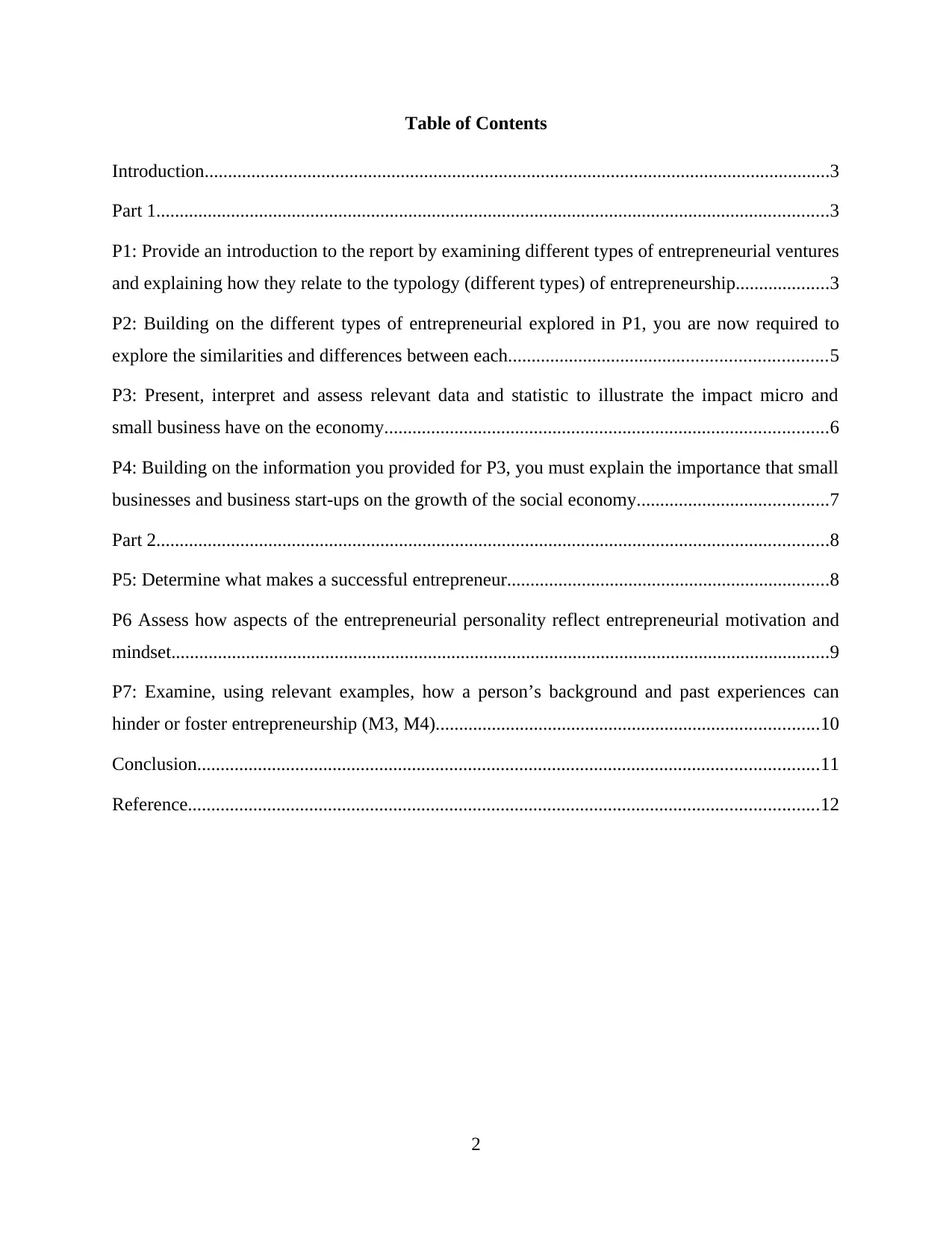
Table of Contents
Introduction......................................................................................................................................3
Part 1................................................................................................................................................3
P1: Provide an introduction to the report by examining different types of entrepreneurial ventures
and explaining how they relate to the typology (different types) of entrepreneurship....................3
P2: Building on the different types of entrepreneurial explored in P1, you are now required to
explore the similarities and differences between each....................................................................5
P3: Present, interpret and assess relevant data and statistic to illustrate the impact micro and
small business have on the economy...............................................................................................6
P4: Building on the information you provided for P3, you must explain the importance that small
businesses and business start-ups on the growth of the social economy.........................................7
Part 2................................................................................................................................................8
P5: Determine what makes a successful entrepreneur.....................................................................8
P6 Assess how aspects of the entrepreneurial personality reflect entrepreneurial motivation and
mindset.............................................................................................................................................9
P7: Examine, using relevant examples, how a person’s background and past experiences can
hinder or foster entrepreneurship (M3, M4)..................................................................................10
Conclusion.....................................................................................................................................11
Reference.......................................................................................................................................12
2
Introduction......................................................................................................................................3
Part 1................................................................................................................................................3
P1: Provide an introduction to the report by examining different types of entrepreneurial ventures
and explaining how they relate to the typology (different types) of entrepreneurship....................3
P2: Building on the different types of entrepreneurial explored in P1, you are now required to
explore the similarities and differences between each....................................................................5
P3: Present, interpret and assess relevant data and statistic to illustrate the impact micro and
small business have on the economy...............................................................................................6
P4: Building on the information you provided for P3, you must explain the importance that small
businesses and business start-ups on the growth of the social economy.........................................7
Part 2................................................................................................................................................8
P5: Determine what makes a successful entrepreneur.....................................................................8
P6 Assess how aspects of the entrepreneurial personality reflect entrepreneurial motivation and
mindset.............................................................................................................................................9
P7: Examine, using relevant examples, how a person’s background and past experiences can
hinder or foster entrepreneurship (M3, M4)..................................................................................10
Conclusion.....................................................................................................................................11
Reference.......................................................................................................................................12
2
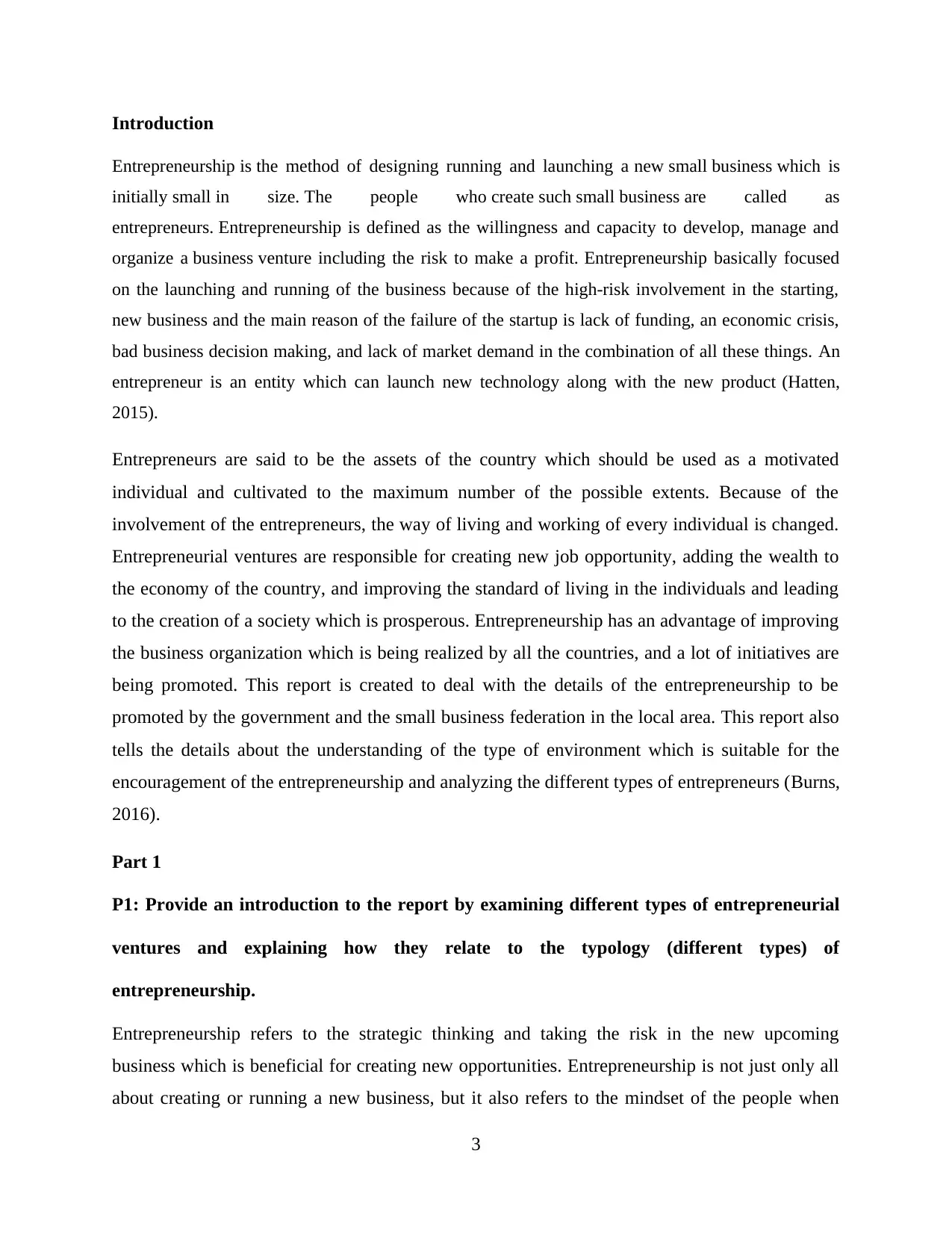
Introduction
Entrepreneurship is the method of designing running and launching a new small business which is
initially small in size. The people who create such small business are called as
entrepreneurs. Entrepreneurship is defined as the willingness and capacity to develop, manage and
organize a business venture including the risk to make a profit. Entrepreneurship basically focused
on the launching and running of the business because of the high-risk involvement in the starting,
new business and the main reason of the failure of the startup is lack of funding, an economic crisis,
bad business decision making, and lack of market demand in the combination of all these things. An
entrepreneur is an entity which can launch new technology along with the new product (Hatten,
2015).
Entrepreneurs are said to be the assets of the country which should be used as a motivated
individual and cultivated to the maximum number of the possible extents. Because of the
involvement of the entrepreneurs, the way of living and working of every individual is changed.
Entrepreneurial ventures are responsible for creating new job opportunity, adding the wealth to
the economy of the country, and improving the standard of living in the individuals and leading
to the creation of a society which is prosperous. Entrepreneurship has an advantage of improving
the business organization which is being realized by all the countries, and a lot of initiatives are
being promoted. This report is created to deal with the details of the entrepreneurship to be
promoted by the government and the small business federation in the local area. This report also
tells the details about the understanding of the type of environment which is suitable for the
encouragement of the entrepreneurship and analyzing the different types of entrepreneurs (Burns,
2016).
Part 1
P1: Provide an introduction to the report by examining different types of entrepreneurial
ventures and explaining how they relate to the typology (different types) of
entrepreneurship.
Entrepreneurship refers to the strategic thinking and taking the risk in the new upcoming
business which is beneficial for creating new opportunities. Entrepreneurship is not just only all
about creating or running a new business, but it also refers to the mindset of the people when
3
Entrepreneurship is the method of designing running and launching a new small business which is
initially small in size. The people who create such small business are called as
entrepreneurs. Entrepreneurship is defined as the willingness and capacity to develop, manage and
organize a business venture including the risk to make a profit. Entrepreneurship basically focused
on the launching and running of the business because of the high-risk involvement in the starting,
new business and the main reason of the failure of the startup is lack of funding, an economic crisis,
bad business decision making, and lack of market demand in the combination of all these things. An
entrepreneur is an entity which can launch new technology along with the new product (Hatten,
2015).
Entrepreneurs are said to be the assets of the country which should be used as a motivated
individual and cultivated to the maximum number of the possible extents. Because of the
involvement of the entrepreneurs, the way of living and working of every individual is changed.
Entrepreneurial ventures are responsible for creating new job opportunity, adding the wealth to
the economy of the country, and improving the standard of living in the individuals and leading
to the creation of a society which is prosperous. Entrepreneurship has an advantage of improving
the business organization which is being realized by all the countries, and a lot of initiatives are
being promoted. This report is created to deal with the details of the entrepreneurship to be
promoted by the government and the small business federation in the local area. This report also
tells the details about the understanding of the type of environment which is suitable for the
encouragement of the entrepreneurship and analyzing the different types of entrepreneurs (Burns,
2016).
Part 1
P1: Provide an introduction to the report by examining different types of entrepreneurial
ventures and explaining how they relate to the typology (different types) of
entrepreneurship.
Entrepreneurship refers to the strategic thinking and taking the risk in the new upcoming
business which is beneficial for creating new opportunities. Entrepreneurship is not just only all
about creating or running a new business, but it also refers to the mindset of the people when
3
⊘ This is a preview!⊘
Do you want full access?
Subscribe today to unlock all pages.

Trusted by 1+ million students worldwide
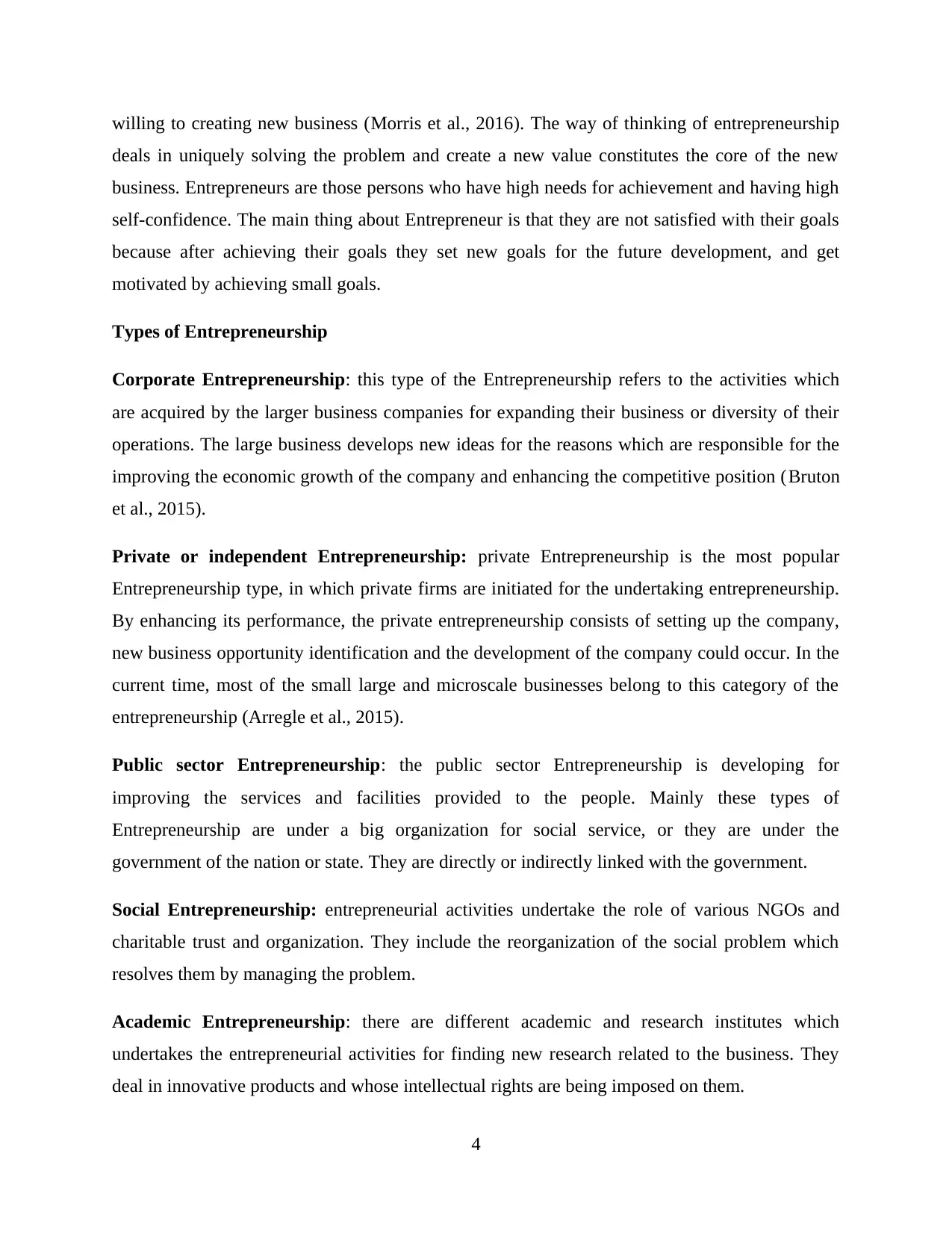
willing to creating new business (Morris et al., 2016). The way of thinking of entrepreneurship
deals in uniquely solving the problem and create a new value constitutes the core of the new
business. Entrepreneurs are those persons who have high needs for achievement and having high
self-confidence. The main thing about Entrepreneur is that they are not satisfied with their goals
because after achieving their goals they set new goals for the future development, and get
motivated by achieving small goals.
Types of Entrepreneurship
Corporate Entrepreneurship: this type of the Entrepreneurship refers to the activities which
are acquired by the larger business companies for expanding their business or diversity of their
operations. The large business develops new ideas for the reasons which are responsible for the
improving the economic growth of the company and enhancing the competitive position (Bruton
et al., 2015).
Private or independent Entrepreneurship: private Entrepreneurship is the most popular
Entrepreneurship type, in which private firms are initiated for the undertaking entrepreneurship.
By enhancing its performance, the private entrepreneurship consists of setting up the company,
new business opportunity identification and the development of the company could occur. In the
current time, most of the small large and microscale businesses belong to this category of the
entrepreneurship (Arregle et al., 2015).
Public sector Entrepreneurship: the public sector Entrepreneurship is developing for
improving the services and facilities provided to the people. Mainly these types of
Entrepreneurship are under a big organization for social service, or they are under the
government of the nation or state. They are directly or indirectly linked with the government.
Social Entrepreneurship: entrepreneurial activities undertake the role of various NGOs and
charitable trust and organization. They include the reorganization of the social problem which
resolves them by managing the problem.
Academic Entrepreneurship: there are different academic and research institutes which
undertakes the entrepreneurial activities for finding new research related to the business. They
deal in innovative products and whose intellectual rights are being imposed on them.
4
deals in uniquely solving the problem and create a new value constitutes the core of the new
business. Entrepreneurs are those persons who have high needs for achievement and having high
self-confidence. The main thing about Entrepreneur is that they are not satisfied with their goals
because after achieving their goals they set new goals for the future development, and get
motivated by achieving small goals.
Types of Entrepreneurship
Corporate Entrepreneurship: this type of the Entrepreneurship refers to the activities which
are acquired by the larger business companies for expanding their business or diversity of their
operations. The large business develops new ideas for the reasons which are responsible for the
improving the economic growth of the company and enhancing the competitive position (Bruton
et al., 2015).
Private or independent Entrepreneurship: private Entrepreneurship is the most popular
Entrepreneurship type, in which private firms are initiated for the undertaking entrepreneurship.
By enhancing its performance, the private entrepreneurship consists of setting up the company,
new business opportunity identification and the development of the company could occur. In the
current time, most of the small large and microscale businesses belong to this category of the
entrepreneurship (Arregle et al., 2015).
Public sector Entrepreneurship: the public sector Entrepreneurship is developing for
improving the services and facilities provided to the people. Mainly these types of
Entrepreneurship are under a big organization for social service, or they are under the
government of the nation or state. They are directly or indirectly linked with the government.
Social Entrepreneurship: entrepreneurial activities undertake the role of various NGOs and
charitable trust and organization. They include the reorganization of the social problem which
resolves them by managing the problem.
Academic Entrepreneurship: there are different academic and research institutes which
undertakes the entrepreneurial activities for finding new research related to the business. They
deal in innovative products and whose intellectual rights are being imposed on them.
4
Paraphrase This Document
Need a fresh take? Get an instant paraphrase of this document with our AI Paraphraser
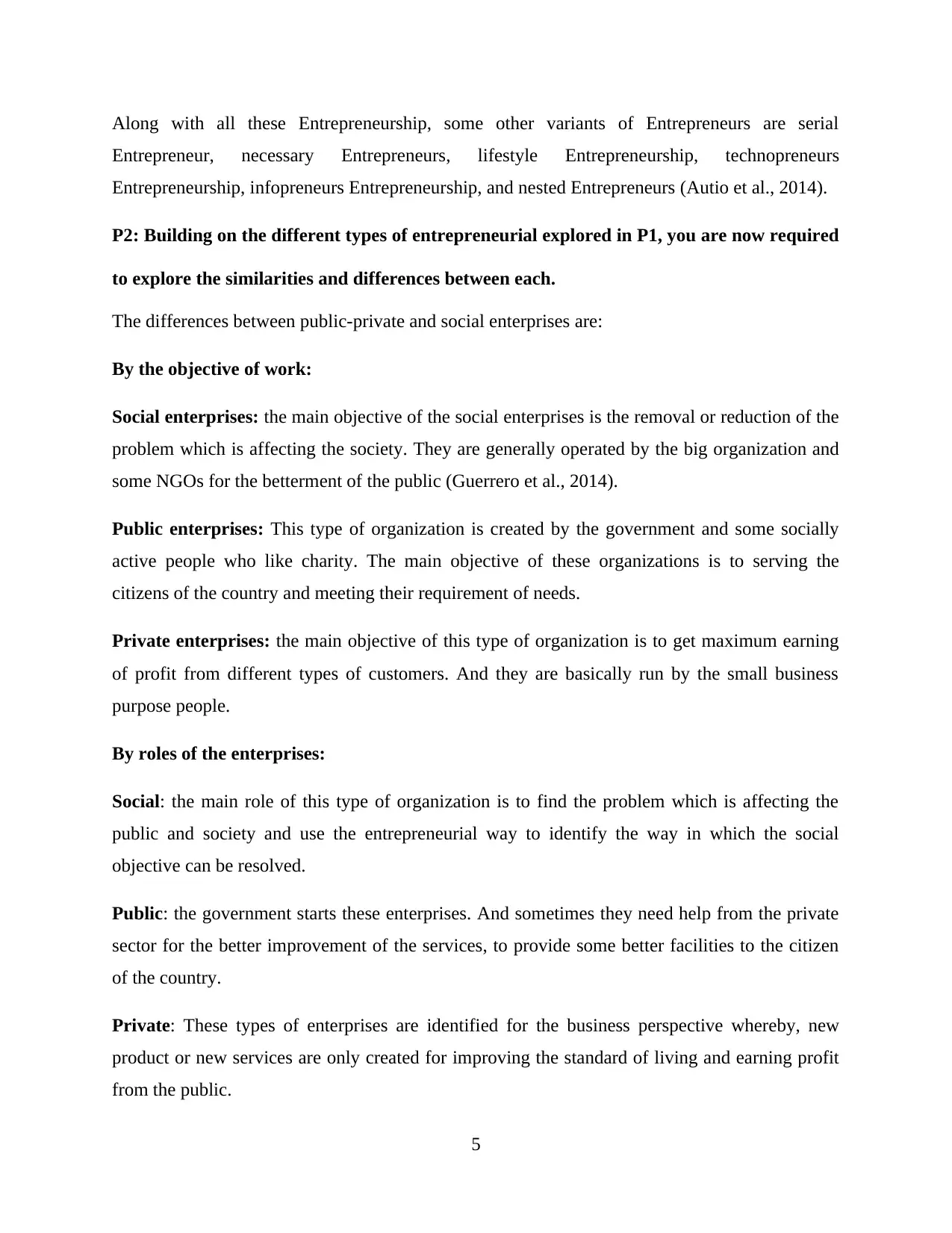
Along with all these Entrepreneurship, some other variants of Entrepreneurs are serial
Entrepreneur, necessary Entrepreneurs, lifestyle Entrepreneurship, technopreneurs
Entrepreneurship, infopreneurs Entrepreneurship, and nested Entrepreneurs (Autio et al., 2014).
P2: Building on the different types of entrepreneurial explored in P1, you are now required
to explore the similarities and differences between each.
The differences between public-private and social enterprises are:
By the objective of work:
Social enterprises: the main objective of the social enterprises is the removal or reduction of the
problem which is affecting the society. They are generally operated by the big organization and
some NGOs for the betterment of the public (Guerrero et al., 2014).
Public enterprises: This type of organization is created by the government and some socially
active people who like charity. The main objective of these organizations is to serving the
citizens of the country and meeting their requirement of needs.
Private enterprises: the main objective of this type of organization is to get maximum earning
of profit from different types of customers. And they are basically run by the small business
purpose people.
By roles of the enterprises:
Social: the main role of this type of organization is to find the problem which is affecting the
public and society and use the entrepreneurial way to identify the way in which the social
objective can be resolved.
Public: the government starts these enterprises. And sometimes they need help from the private
sector for the better improvement of the services, to provide some better facilities to the citizen
of the country.
Private: These types of enterprises are identified for the business perspective whereby, new
product or new services are only created for improving the standard of living and earning profit
from the public.
5
Entrepreneur, necessary Entrepreneurs, lifestyle Entrepreneurship, technopreneurs
Entrepreneurship, infopreneurs Entrepreneurship, and nested Entrepreneurs (Autio et al., 2014).
P2: Building on the different types of entrepreneurial explored in P1, you are now required
to explore the similarities and differences between each.
The differences between public-private and social enterprises are:
By the objective of work:
Social enterprises: the main objective of the social enterprises is the removal or reduction of the
problem which is affecting the society. They are generally operated by the big organization and
some NGOs for the betterment of the public (Guerrero et al., 2014).
Public enterprises: This type of organization is created by the government and some socially
active people who like charity. The main objective of these organizations is to serving the
citizens of the country and meeting their requirement of needs.
Private enterprises: the main objective of this type of organization is to get maximum earning
of profit from different types of customers. And they are basically run by the small business
purpose people.
By roles of the enterprises:
Social: the main role of this type of organization is to find the problem which is affecting the
public and society and use the entrepreneurial way to identify the way in which the social
objective can be resolved.
Public: the government starts these enterprises. And sometimes they need help from the private
sector for the better improvement of the services, to provide some better facilities to the citizen
of the country.
Private: These types of enterprises are identified for the business perspective whereby, new
product or new services are only created for improving the standard of living and earning profit
from the public.
5

By Characteristics
Social: they raise their funds mainly from donation, and their aim is not to earn profits.
Public: their funds are raised from the different taxes and penalty and duty funds. They want to
earn a profit for the better growth of the public.
Private: they acquire funds from personal savings and loans from different banks or issuing
there the shares (Rabellotti, 2016)
These entrepreneurial also have a verity of similarities, and they are:
1. All of the enterprises have the same role in eliminating the problem being faced during the
establishment or starting of an entrepreneurial venture.
2. They all have the same goal to analyze the problem which is being faced by the public and
convert all those problems into the opportunity of business.
3. They all are risk takers because the new services and products that are provided by them are
innovated, and there is a high chance of failure of the product.
4. All have the high scope of development because of the innovative approach applied to them.
P3: Present, interpret and assess relevant data and statistic to illustrate the impact micro
and small business have on the economy.
Small and micro business has a deep impact on countries, and it is extremely important for the
growth and development of the country and global economy. And these enterprises are generally
private entrepreneurial ventures and operated by the private people of the group, independently
(Bruhn et al., 2018). Because of these organizations, they employ a large number of individuals.
A very small number of micro and small-scale enterprises are operated within the country. From
the statistics provided by the U.K government, in private sector, there are more than 5.6 million
business organizations which are being operated in the private sector in which around 99.3 % of
business is being covered by both the small and micro-scale enterprises. These small and micro
scale businesses are extremely important for the growth and development of the country and its
economy because this small and microscale business covers more than 1.8 trillion euro of
6
Social: they raise their funds mainly from donation, and their aim is not to earn profits.
Public: their funds are raised from the different taxes and penalty and duty funds. They want to
earn a profit for the better growth of the public.
Private: they acquire funds from personal savings and loans from different banks or issuing
there the shares (Rabellotti, 2016)
These entrepreneurial also have a verity of similarities, and they are:
1. All of the enterprises have the same role in eliminating the problem being faced during the
establishment or starting of an entrepreneurial venture.
2. They all have the same goal to analyze the problem which is being faced by the public and
convert all those problems into the opportunity of business.
3. They all are risk takers because the new services and products that are provided by them are
innovated, and there is a high chance of failure of the product.
4. All have the high scope of development because of the innovative approach applied to them.
P3: Present, interpret and assess relevant data and statistic to illustrate the impact micro
and small business have on the economy.
Small and micro business has a deep impact on countries, and it is extremely important for the
growth and development of the country and global economy. And these enterprises are generally
private entrepreneurial ventures and operated by the private people of the group, independently
(Bruhn et al., 2018). Because of these organizations, they employ a large number of individuals.
A very small number of micro and small-scale enterprises are operated within the country. From
the statistics provided by the U.K government, in private sector, there are more than 5.6 million
business organizations which are being operated in the private sector in which around 99.3 % of
business is being covered by both the small and micro-scale enterprises. These small and micro
scale businesses are extremely important for the growth and development of the country and its
economy because this small and microscale business covers more than 1.8 trillion euro of
6
⊘ This is a preview!⊘
Do you want full access?
Subscribe today to unlock all pages.

Trusted by 1+ million students worldwide
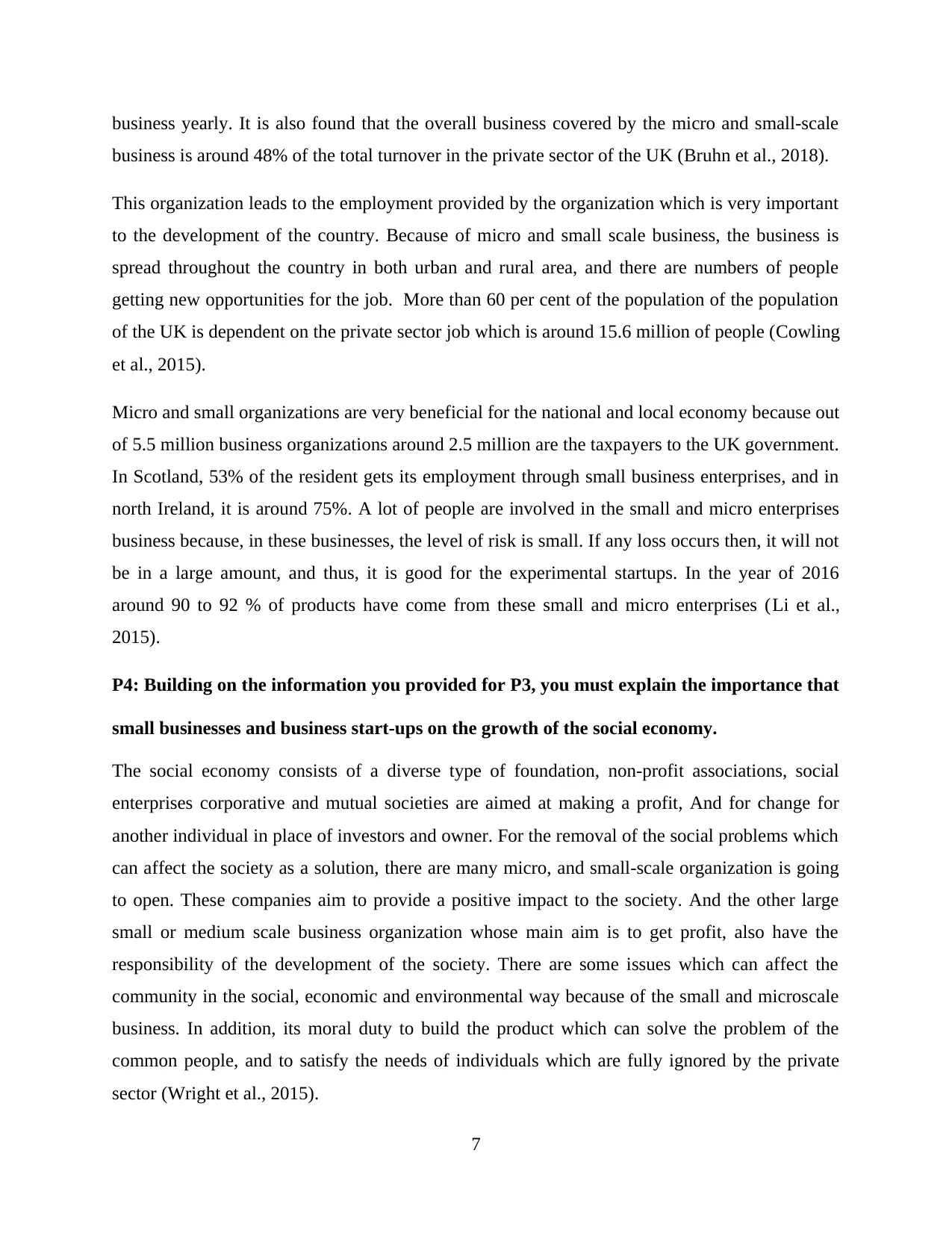
business yearly. It is also found that the overall business covered by the micro and small-scale
business is around 48% of the total turnover in the private sector of the UK (Bruhn et al., 2018).
This organization leads to the employment provided by the organization which is very important
to the development of the country. Because of micro and small scale business, the business is
spread throughout the country in both urban and rural area, and there are numbers of people
getting new opportunities for the job. More than 60 per cent of the population of the population
of the UK is dependent on the private sector job which is around 15.6 million of people (Cowling
et al., 2015).
Micro and small organizations are very beneficial for the national and local economy because out
of 5.5 million business organizations around 2.5 million are the taxpayers to the UK government.
In Scotland, 53% of the resident gets its employment through small business enterprises, and in
north Ireland, it is around 75%. A lot of people are involved in the small and micro enterprises
business because, in these businesses, the level of risk is small. If any loss occurs then, it will not
be in a large amount, and thus, it is good for the experimental startups. In the year of 2016
around 90 to 92 % of products have come from these small and micro enterprises (Li et al.,
2015).
P4: Building on the information you provided for P3, you must explain the importance that
small businesses and business start-ups on the growth of the social economy.
The social economy consists of a diverse type of foundation, non-profit associations, social
enterprises corporative and mutual societies are aimed at making a profit, And for change for
another individual in place of investors and owner. For the removal of the social problems which
can affect the society as a solution, there are many micro, and small-scale organization is going
to open. These companies aim to provide a positive impact to the society. And the other large
small or medium scale business organization whose main aim is to get profit, also have the
responsibility of the development of the society. There are some issues which can affect the
community in the social, economic and environmental way because of the small and microscale
business. In addition, its moral duty to build the product which can solve the problem of the
common people, and to satisfy the needs of individuals which are fully ignored by the private
sector (Wright et al., 2015).
7
business is around 48% of the total turnover in the private sector of the UK (Bruhn et al., 2018).
This organization leads to the employment provided by the organization which is very important
to the development of the country. Because of micro and small scale business, the business is
spread throughout the country in both urban and rural area, and there are numbers of people
getting new opportunities for the job. More than 60 per cent of the population of the population
of the UK is dependent on the private sector job which is around 15.6 million of people (Cowling
et al., 2015).
Micro and small organizations are very beneficial for the national and local economy because out
of 5.5 million business organizations around 2.5 million are the taxpayers to the UK government.
In Scotland, 53% of the resident gets its employment through small business enterprises, and in
north Ireland, it is around 75%. A lot of people are involved in the small and micro enterprises
business because, in these businesses, the level of risk is small. If any loss occurs then, it will not
be in a large amount, and thus, it is good for the experimental startups. In the year of 2016
around 90 to 92 % of products have come from these small and micro enterprises (Li et al.,
2015).
P4: Building on the information you provided for P3, you must explain the importance that
small businesses and business start-ups on the growth of the social economy.
The social economy consists of a diverse type of foundation, non-profit associations, social
enterprises corporative and mutual societies are aimed at making a profit, And for change for
another individual in place of investors and owner. For the removal of the social problems which
can affect the society as a solution, there are many micro, and small-scale organization is going
to open. These companies aim to provide a positive impact to the society. And the other large
small or medium scale business organization whose main aim is to get profit, also have the
responsibility of the development of the society. There are some issues which can affect the
community in the social, economic and environmental way because of the small and microscale
business. In addition, its moral duty to build the product which can solve the problem of the
common people, and to satisfy the needs of individuals which are fully ignored by the private
sector (Wright et al., 2015).
7
Paraphrase This Document
Need a fresh take? Get an instant paraphrase of this document with our AI Paraphraser

Because of the initiative was taken by the small business and startups to make the difference in
the society has a deep impact on the growth of the social economy. The small and medium scale
business identifies the problems which are connected to the society and develop the different
kinds of product to serve the citizen of the country for every requirement. For the profitable
strong, inclusive and sustainable society all the organization has to understand the needs of the
public. There are different types of responsibility of the corporate society whose initiatives are
brought by the startups and small-scale business to get the social development. It is the
responsibility of the big organization to make a charity for the different type of problem which is
associated with the society and to donate to them. According to the survey, it is more than one
out of four business companies in the UK is undertaken the social mission and donated around
55 billion euro for the contribution to the society, and increases the economy of the country. For
the growth of the UK economy, the social finance, social enterprises and social investment have
played an important role (Giaoutzi et al., 2016).
Part 2
P5: Determine what makes a successful entrepreneur.
There are many successful entrepreneurs like Mark Zuckerberg, Bill Gates and Richard Branson
and they all have skills and particular characteristics that set them apart from the other
entrepreneurs. Due to their creativity level intellectual and innovation they give an impression
that entrepreneurship is embedded in their DNA. But this is not the point that all the
entrepreneurs have attributes traits and their skills but it is just a matter of luck and
understanding the problem, and in that problem, they must look for the scope (Tasnim et al.,
2014).
Skills which are required by all entrepreneurs are communication, managing and planning, and
teamwork and interpersonal skills.
For entrepreneurs, a great teamwork always provides the success to the organization. Because of
teamwork many conflicts can be resolved within a small interval of time. Because an entire
company cannot run alone and the employees are connected to the company, it plays an
important role in the overall growth of the company.
8
the society has a deep impact on the growth of the social economy. The small and medium scale
business identifies the problems which are connected to the society and develop the different
kinds of product to serve the citizen of the country for every requirement. For the profitable
strong, inclusive and sustainable society all the organization has to understand the needs of the
public. There are different types of responsibility of the corporate society whose initiatives are
brought by the startups and small-scale business to get the social development. It is the
responsibility of the big organization to make a charity for the different type of problem which is
associated with the society and to donate to them. According to the survey, it is more than one
out of four business companies in the UK is undertaken the social mission and donated around
55 billion euro for the contribution to the society, and increases the economy of the country. For
the growth of the UK economy, the social finance, social enterprises and social investment have
played an important role (Giaoutzi et al., 2016).
Part 2
P5: Determine what makes a successful entrepreneur.
There are many successful entrepreneurs like Mark Zuckerberg, Bill Gates and Richard Branson
and they all have skills and particular characteristics that set them apart from the other
entrepreneurs. Due to their creativity level intellectual and innovation they give an impression
that entrepreneurship is embedded in their DNA. But this is not the point that all the
entrepreneurs have attributes traits and their skills but it is just a matter of luck and
understanding the problem, and in that problem, they must look for the scope (Tasnim et al.,
2014).
Skills which are required by all entrepreneurs are communication, managing and planning, and
teamwork and interpersonal skills.
For entrepreneurs, a great teamwork always provides the success to the organization. Because of
teamwork many conflicts can be resolved within a small interval of time. Because an entire
company cannot run alone and the employees are connected to the company, it plays an
important role in the overall growth of the company.
8
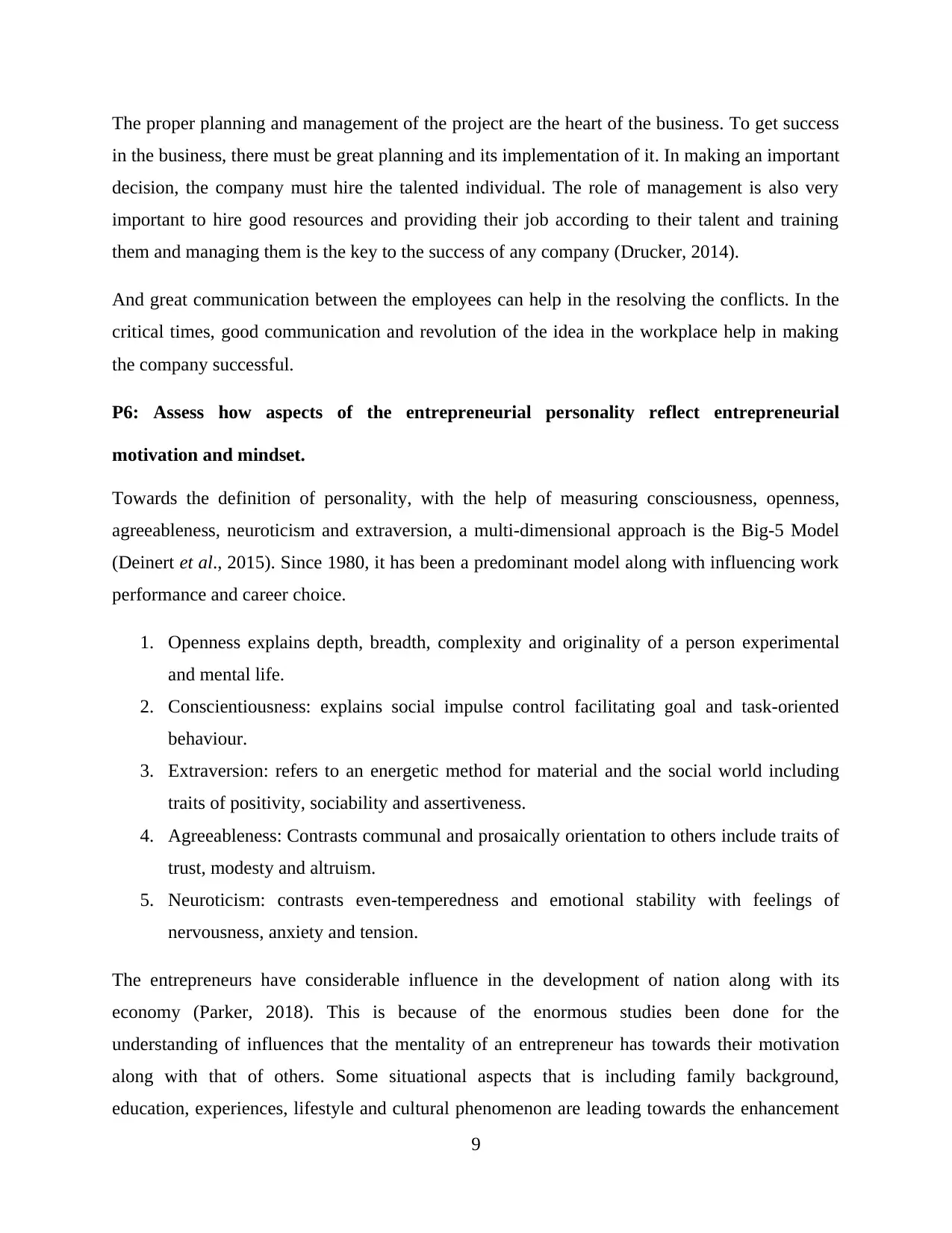
The proper planning and management of the project are the heart of the business. To get success
in the business, there must be great planning and its implementation of it. In making an important
decision, the company must hire the talented individual. The role of management is also very
important to hire good resources and providing their job according to their talent and training
them and managing them is the key to the success of any company (Drucker, 2014).
And great communication between the employees can help in the resolving the conflicts. In the
critical times, good communication and revolution of the idea in the workplace help in making
the company successful.
P6: Assess how aspects of the entrepreneurial personality reflect entrepreneurial
motivation and mindset.
Towards the definition of personality, with the help of measuring consciousness, openness,
agreeableness, neuroticism and extraversion, a multi-dimensional approach is the Big-5 Model
(Deinert et al., 2015). Since 1980, it has been a predominant model along with influencing work
performance and career choice.
1. Openness explains depth, breadth, complexity and originality of a person experimental
and mental life.
2. Conscientiousness: explains social impulse control facilitating goal and task-oriented
behaviour.
3. Extraversion: refers to an energetic method for material and the social world including
traits of positivity, sociability and assertiveness.
4. Agreeableness: Contrasts communal and prosaically orientation to others include traits of
trust, modesty and altruism.
5. Neuroticism: contrasts even-temperedness and emotional stability with feelings of
nervousness, anxiety and tension.
The entrepreneurs have considerable influence in the development of nation along with its
economy (Parker, 2018). This is because of the enormous studies been done for the
understanding of influences that the mentality of an entrepreneur has towards their motivation
along with that of others. Some situational aspects that is including family background,
education, experiences, lifestyle and cultural phenomenon are leading towards the enhancement
9
in the business, there must be great planning and its implementation of it. In making an important
decision, the company must hire the talented individual. The role of management is also very
important to hire good resources and providing their job according to their talent and training
them and managing them is the key to the success of any company (Drucker, 2014).
And great communication between the employees can help in the resolving the conflicts. In the
critical times, good communication and revolution of the idea in the workplace help in making
the company successful.
P6: Assess how aspects of the entrepreneurial personality reflect entrepreneurial
motivation and mindset.
Towards the definition of personality, with the help of measuring consciousness, openness,
agreeableness, neuroticism and extraversion, a multi-dimensional approach is the Big-5 Model
(Deinert et al., 2015). Since 1980, it has been a predominant model along with influencing work
performance and career choice.
1. Openness explains depth, breadth, complexity and originality of a person experimental
and mental life.
2. Conscientiousness: explains social impulse control facilitating goal and task-oriented
behaviour.
3. Extraversion: refers to an energetic method for material and the social world including
traits of positivity, sociability and assertiveness.
4. Agreeableness: Contrasts communal and prosaically orientation to others include traits of
trust, modesty and altruism.
5. Neuroticism: contrasts even-temperedness and emotional stability with feelings of
nervousness, anxiety and tension.
The entrepreneurs have considerable influence in the development of nation along with its
economy (Parker, 2018). This is because of the enormous studies been done for the
understanding of influences that the mentality of an entrepreneur has towards their motivation
along with that of others. Some situational aspects that is including family background,
education, experiences, lifestyle and cultural phenomenon are leading towards the enhancement
9
⊘ This is a preview!⊘
Do you want full access?
Subscribe today to unlock all pages.

Trusted by 1+ million students worldwide
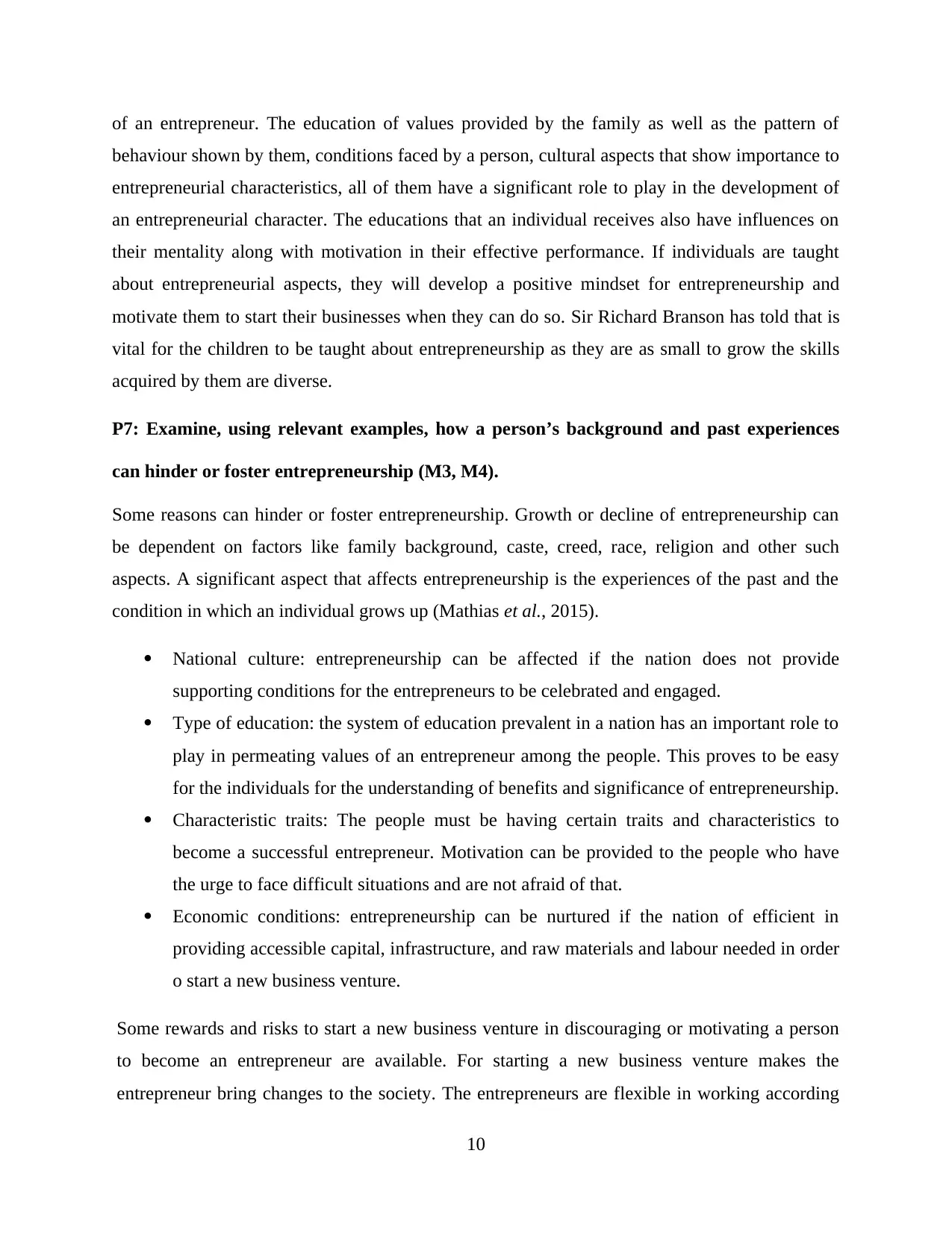
of an entrepreneur. The education of values provided by the family as well as the pattern of
behaviour shown by them, conditions faced by a person, cultural aspects that show importance to
entrepreneurial characteristics, all of them have a significant role to play in the development of
an entrepreneurial character. The educations that an individual receives also have influences on
their mentality along with motivation in their effective performance. If individuals are taught
about entrepreneurial aspects, they will develop a positive mindset for entrepreneurship and
motivate them to start their businesses when they can do so. Sir Richard Branson has told that is
vital for the children to be taught about entrepreneurship as they are as small to grow the skills
acquired by them are diverse.
P7: Examine, using relevant examples, how a person’s background and past experiences
can hinder or foster entrepreneurship (M3, M4).
Some reasons can hinder or foster entrepreneurship. Growth or decline of entrepreneurship can
be dependent on factors like family background, caste, creed, race, religion and other such
aspects. A significant aspect that affects entrepreneurship is the experiences of the past and the
condition in which an individual grows up (Mathias et al., 2015).
National culture: entrepreneurship can be affected if the nation does not provide
supporting conditions for the entrepreneurs to be celebrated and engaged.
Type of education: the system of education prevalent in a nation has an important role to
play in permeating values of an entrepreneur among the people. This proves to be easy
for the individuals for the understanding of benefits and significance of entrepreneurship.
Characteristic traits: The people must be having certain traits and characteristics to
become a successful entrepreneur. Motivation can be provided to the people who have
the urge to face difficult situations and are not afraid of that.
Economic conditions: entrepreneurship can be nurtured if the nation of efficient in
providing accessible capital, infrastructure, and raw materials and labour needed in order
o start a new business venture.
Some rewards and risks to start a new business venture in discouraging or motivating a person
to become an entrepreneur are available. For starting a new business venture makes the
entrepreneur bring changes to the society. The entrepreneurs are flexible in working according
10
behaviour shown by them, conditions faced by a person, cultural aspects that show importance to
entrepreneurial characteristics, all of them have a significant role to play in the development of
an entrepreneurial character. The educations that an individual receives also have influences on
their mentality along with motivation in their effective performance. If individuals are taught
about entrepreneurial aspects, they will develop a positive mindset for entrepreneurship and
motivate them to start their businesses when they can do so. Sir Richard Branson has told that is
vital for the children to be taught about entrepreneurship as they are as small to grow the skills
acquired by them are diverse.
P7: Examine, using relevant examples, how a person’s background and past experiences
can hinder or foster entrepreneurship (M3, M4).
Some reasons can hinder or foster entrepreneurship. Growth or decline of entrepreneurship can
be dependent on factors like family background, caste, creed, race, religion and other such
aspects. A significant aspect that affects entrepreneurship is the experiences of the past and the
condition in which an individual grows up (Mathias et al., 2015).
National culture: entrepreneurship can be affected if the nation does not provide
supporting conditions for the entrepreneurs to be celebrated and engaged.
Type of education: the system of education prevalent in a nation has an important role to
play in permeating values of an entrepreneur among the people. This proves to be easy
for the individuals for the understanding of benefits and significance of entrepreneurship.
Characteristic traits: The people must be having certain traits and characteristics to
become a successful entrepreneur. Motivation can be provided to the people who have
the urge to face difficult situations and are not afraid of that.
Economic conditions: entrepreneurship can be nurtured if the nation of efficient in
providing accessible capital, infrastructure, and raw materials and labour needed in order
o start a new business venture.
Some rewards and risks to start a new business venture in discouraging or motivating a person
to become an entrepreneur are available. For starting a new business venture makes the
entrepreneur bring changes to the society. The entrepreneurs are flexible in working according
10
Paraphrase This Document
Need a fresh take? Get an instant paraphrase of this document with our AI Paraphraser

to their preference. However, the entrepreneurs face an insecure flow of fund, being one of the
main problems of the company for gaining profits. The entrepreneur needs to follow a steady
and strict schedule to achieve the objectives, although they may have to face an excess of the
workload at times.
Conclusion
It can be concluded that the entrepreneurship is very important to the growth of both nations as
well as global economy. It is also very important that government of any nation take measures in
the promotion of entrepreneurship in all across the country. In this report, we came to know that
the different types of entrepreneurship and its funding and all the details of the organization. And
what makes the motivation of the entrepreneurs to grow faster. There are several types of
entrepreneurship which can undertake by the individual. The different roles of government for
the promotion of the entrepreneurship have been defined in the above study that has been
distinguished in the paper as per the perspective of the future development. We have seen the
role of micro and small scale company has impacted in the UK. And finally, understand the main
reason for the success of the entrepreneurship.
11
main problems of the company for gaining profits. The entrepreneur needs to follow a steady
and strict schedule to achieve the objectives, although they may have to face an excess of the
workload at times.
Conclusion
It can be concluded that the entrepreneurship is very important to the growth of both nations as
well as global economy. It is also very important that government of any nation take measures in
the promotion of entrepreneurship in all across the country. In this report, we came to know that
the different types of entrepreneurship and its funding and all the details of the organization. And
what makes the motivation of the entrepreneurs to grow faster. There are several types of
entrepreneurship which can undertake by the individual. The different roles of government for
the promotion of the entrepreneurship have been defined in the above study that has been
distinguished in the paper as per the perspective of the future development. We have seen the
role of micro and small scale company has impacted in the UK. And finally, understand the main
reason for the success of the entrepreneurship.
11
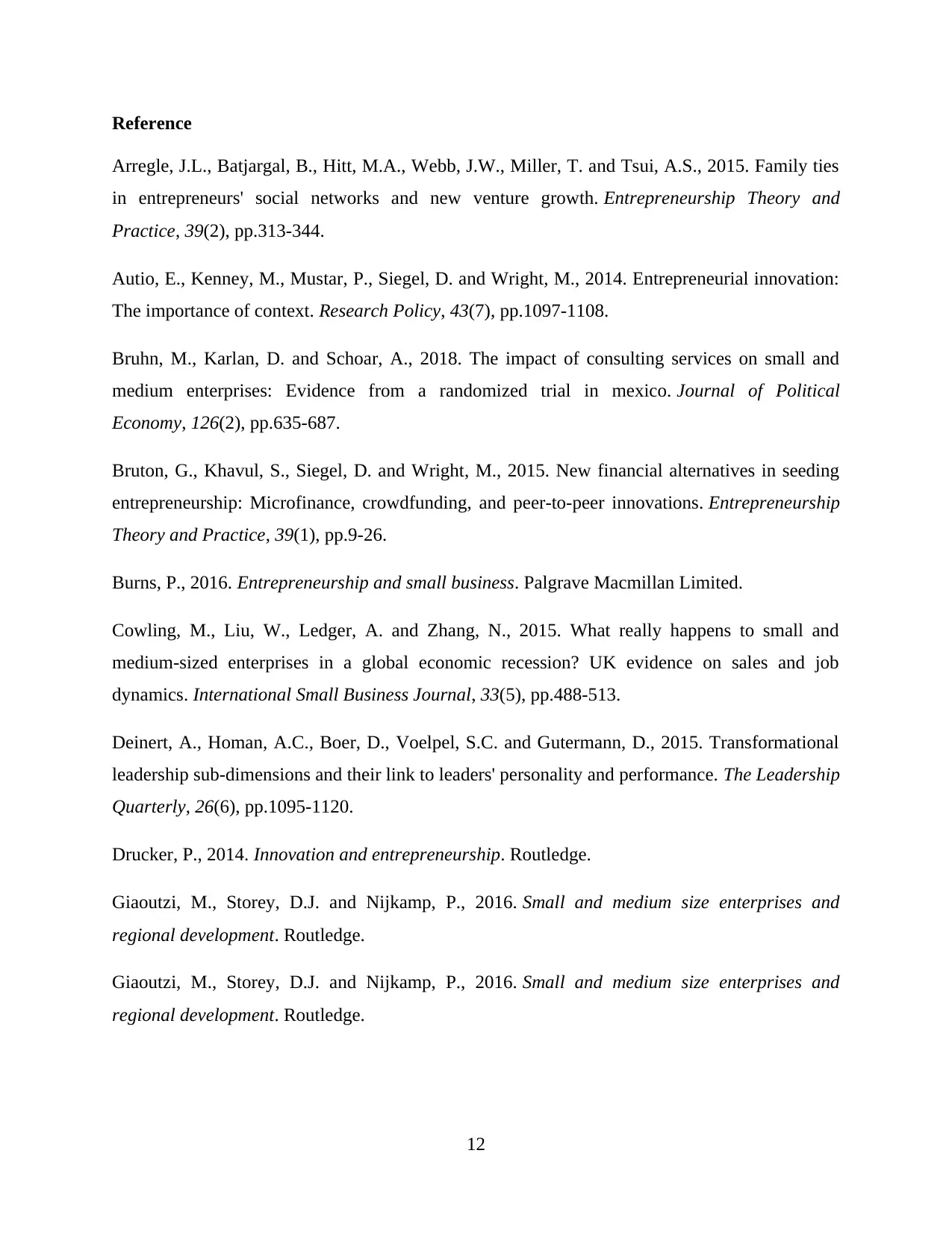
Reference
Arregle, J.L., Batjargal, B., Hitt, M.A., Webb, J.W., Miller, T. and Tsui, A.S., 2015. Family ties
in entrepreneurs' social networks and new venture growth. Entrepreneurship Theory and
Practice, 39(2), pp.313-344.
Autio, E., Kenney, M., Mustar, P., Siegel, D. and Wright, M., 2014. Entrepreneurial innovation:
The importance of context. Research Policy, 43(7), pp.1097-1108.
Bruhn, M., Karlan, D. and Schoar, A., 2018. The impact of consulting services on small and
medium enterprises: Evidence from a randomized trial in mexico. Journal of Political
Economy, 126(2), pp.635-687.
Bruton, G., Khavul, S., Siegel, D. and Wright, M., 2015. New financial alternatives in seeding
entrepreneurship: Microfinance, crowdfunding, and peer‐to‐peer innovations. Entrepreneurship
Theory and Practice, 39(1), pp.9-26.
Burns, P., 2016. Entrepreneurship and small business. Palgrave Macmillan Limited.
Cowling, M., Liu, W., Ledger, A. and Zhang, N., 2015. What really happens to small and
medium-sized enterprises in a global economic recession? UK evidence on sales and job
dynamics. International Small Business Journal, 33(5), pp.488-513.
Deinert, A., Homan, A.C., Boer, D., Voelpel, S.C. and Gutermann, D., 2015. Transformational
leadership sub-dimensions and their link to leaders' personality and performance. The Leadership
Quarterly, 26(6), pp.1095-1120.
Drucker, P., 2014. Innovation and entrepreneurship. Routledge.
Giaoutzi, M., Storey, D.J. and Nijkamp, P., 2016. Small and medium size enterprises and
regional development. Routledge.
Giaoutzi, M., Storey, D.J. and Nijkamp, P., 2016. Small and medium size enterprises and
regional development. Routledge.
12
Arregle, J.L., Batjargal, B., Hitt, M.A., Webb, J.W., Miller, T. and Tsui, A.S., 2015. Family ties
in entrepreneurs' social networks and new venture growth. Entrepreneurship Theory and
Practice, 39(2), pp.313-344.
Autio, E., Kenney, M., Mustar, P., Siegel, D. and Wright, M., 2014. Entrepreneurial innovation:
The importance of context. Research Policy, 43(7), pp.1097-1108.
Bruhn, M., Karlan, D. and Schoar, A., 2018. The impact of consulting services on small and
medium enterprises: Evidence from a randomized trial in mexico. Journal of Political
Economy, 126(2), pp.635-687.
Bruton, G., Khavul, S., Siegel, D. and Wright, M., 2015. New financial alternatives in seeding
entrepreneurship: Microfinance, crowdfunding, and peer‐to‐peer innovations. Entrepreneurship
Theory and Practice, 39(1), pp.9-26.
Burns, P., 2016. Entrepreneurship and small business. Palgrave Macmillan Limited.
Cowling, M., Liu, W., Ledger, A. and Zhang, N., 2015. What really happens to small and
medium-sized enterprises in a global economic recession? UK evidence on sales and job
dynamics. International Small Business Journal, 33(5), pp.488-513.
Deinert, A., Homan, A.C., Boer, D., Voelpel, S.C. and Gutermann, D., 2015. Transformational
leadership sub-dimensions and their link to leaders' personality and performance. The Leadership
Quarterly, 26(6), pp.1095-1120.
Drucker, P., 2014. Innovation and entrepreneurship. Routledge.
Giaoutzi, M., Storey, D.J. and Nijkamp, P., 2016. Small and medium size enterprises and
regional development. Routledge.
Giaoutzi, M., Storey, D.J. and Nijkamp, P., 2016. Small and medium size enterprises and
regional development. Routledge.
12
⊘ This is a preview!⊘
Do you want full access?
Subscribe today to unlock all pages.

Trusted by 1+ million students worldwide
1 out of 13
Related Documents
Your All-in-One AI-Powered Toolkit for Academic Success.
+13062052269
info@desklib.com
Available 24*7 on WhatsApp / Email
![[object Object]](/_next/static/media/star-bottom.7253800d.svg)
Unlock your academic potential
Copyright © 2020–2025 A2Z Services. All Rights Reserved. Developed and managed by ZUCOL.


![Entrepreneurship and Small Business Impact Report - [University Name]](/_next/image/?url=https%3A%2F%2Fdesklib.com%2Fmedia%2Fimages%2Fwj%2Fd1f42599211847658d3fd556aa563fa5.jpg&w=256&q=75)

